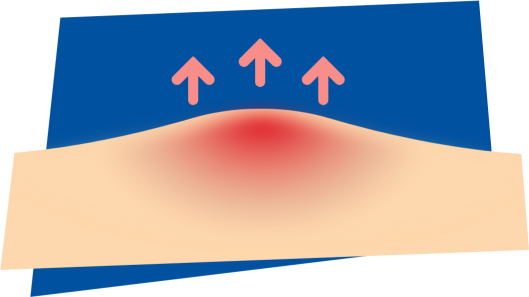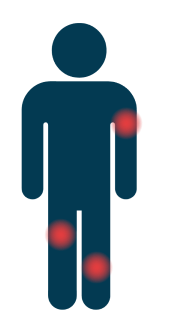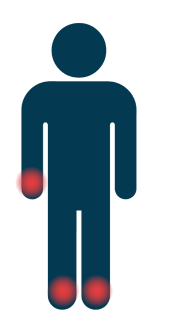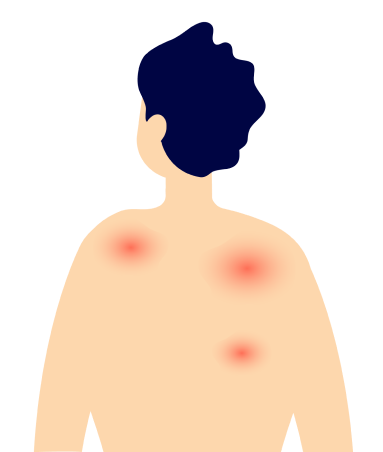What is a FOP flare-up?
People living with FOP may experience unpredictable episodes of soft tissue swelling, pain, reduced movement, stiffness, and warmth, referred to as
flare-ups.
Patients with FOP experience sporadic and unpredictable episodes of soft‐tissue swelling, pain, reduced movement, stiffness and warmth, referred to as ‘flare‐ups’.1
1
Flare-up symptoms usually resolve within eight weeks of onset, although this may take longer if the back or hips are affected. Flare-ups are often associated with the formation of extra bone, known as heterotopic ossification, which can lead to reduced function in the affected area.1
Recognizing the warning signs or symptoms of an FOP flare-up can allow you to get the help you need for yourself or your loved one as soon as possible.

How to recognize a flare-up

A sudden swelling that is red and warm to the touch may be a sign of a FOP flare-up1
FOP symptoms due to a flare-up typically include one or more of the following:1
- Pain
- Swelling
- Redness
- Warmth
- Stiffness
- Decreased range of motion
New swelling and pain are the two symptoms that are most likely to predict a flare-up.1 Other symptoms reported before or during a flare-up included changes in mood or behavior, fever, loss of appetite, and lack of energy.1

A sudden swelling that is red and warm to the touch may be a sign of a FOP flare-up1

Early on in their disease, people living with FOP are more likely to experience flare-ups in their neck, upper back, shoulders and/or chest.1,2

As FOP progresses, flare-ups occur more frequently in the legs and arms.1,2

The joints closest to the center of the body (e.g., elbow, hip, knee) are generally affected first, and the joints further from the center of the body (e.g., ankles, wrists, feet and fingers) are affected later in the disease.1

Take action!
If you suspect a FOP flare-up talk to your doctor as soon as possible.
It is important to let your doctor know about any flare-ups so that they can be managed appropriately. This includes avoiding, or approaching with caution, any action or medical intervention that could cause further bone formation and worsen the condition.3 The 'Let's talk FOP' PDF provides tips on how to discuss FOP with your healthcare provider. Click the link below to download.
Can FOP flare-ups be prevented?
FOP flare-ups can occur without warning or without any obvious cause and cannot always be avoided or prevented.3 However, recognizing some of the main causes of flare-ups can help with prevention.4
Activities or procedures that should be avoided or approached with caution include:3,4
Over-exertion or tiredness
Surgery
Certain dental procedures
Biopsy
Intramuscular
Into the muscle.
injections (such as vaccinations)
Muscular stretching and
passive range of motion exercises
Exercises that involve somebody physically moving or stretching a part of another person's body.2
Injuries, such as bumps, bruises and falls
Vaccinations should be approached with caution, and it is recommended that no immunizations are given during an active flare-up. Certain types of vaccinations are higher risk than others, so you should let your doctor know that the
International Clinical Council (ICC) on FOP

 International Clinical Council (ICC) on FOP
International Clinical Council (ICC) on FOP
The International Clinical Council on FOP, or ICC, is an independent group of internationally-recognized physicians who are clinical experts in FOP.2provides specific vaccination recommendations in the Medical Management of FOP Treatment Considerations3
- For necessary dental procedures, the ICC recommends that overstretching of the mouth should be avoided3
- While activity is encouraged at all ages, it has also been recommended to avoid passive range of motion exercises, meaning when somebody else physically moves or stretches a body part3
If medical procedures do need to take place, the care team should reach out to physicians experienced in treating FOP for advice and support to minimize the risk of flare-ups3
Managing FOP flare-ups

Flare-ups may not give a forewarning, but the associated pain and inflammation can be managed.3
For any questions related to treatment or symptom management, please talk to your doctor or pharmacist.

1. Pignolo RJ et al. J Bone Miner Res 2016;31:650–65. 2. Baujat G et al. Orphanet J Rare Dis 2017:12:123. 3. Kaplan FS et al. Proc Intl Clin Council FOP 2022;1:1–120. 4. Di Rocco M et al. Orphanet J Rare Dis 2017;12:110.

